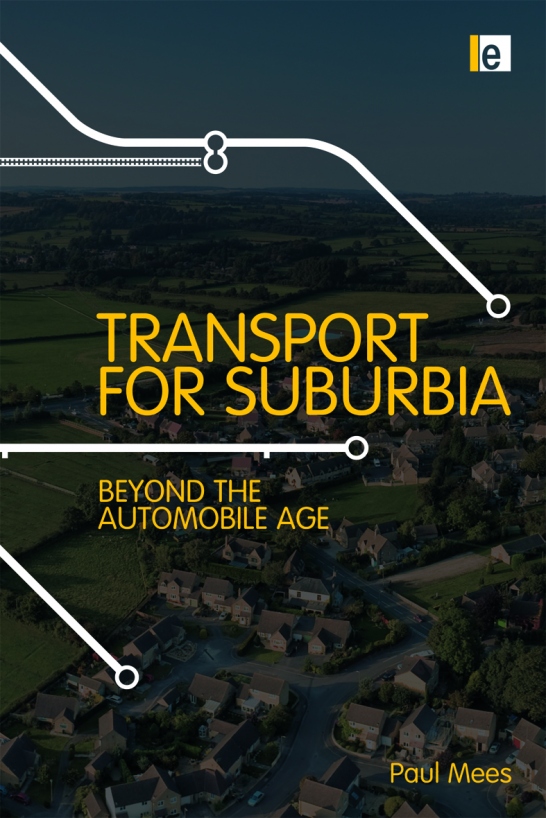Australian transportation planner Paul Mees has good news for people who want real action on global warming — good quality transit is within reach even in the suburbs. But they might have to participate in a revolt against something as reasonable sounding as “balanced transportation” first.
Transport of Suburbia: Beyond the Automobile Age includes a strong argument for public participation in transportation decision making. Mees claims that “citizens have a keener understanding of the need for change than transport planners, with environmental awareness particularly strong among younger residents.”
He includes numerous examples where the public has supported transit investments over expanding roads, and how many transit success stories are the result of the wave of freeway revolts of the 1960s and 1970s. But he also shows how road building advocates have successfully blunted resistance by promising “balanced transportation” with wider roads and improved transit, often with the result that the roads get widened but transit remains an unfunded promise.
Often public transit is presented as if it is a cure-all for transportation emissions. But Mees points out that increased transit ridership only reduces greenhouse gas emissions if it reduces travel by car, and transit vehicle occupancy is high enough. He asserts that the kind of transit often promoted as part of “balanced” plans, commuter transit to park-and-ride lots, frequently results in increased rather than reduced driving and emissions. Transit must provide a real alternative to driving in order to provide significant environmental benefits, and that means stopping road expansion and re-allocating spending to fund high quality transit networks that reach right into suburban residential neighbourhoods.
Mees asserts that low population density in suburban areas is used as an excuse to continue widening roads rather than shifting limited resources to transit — “arguments attributing car dominance to impersonal forces like density are convenient for policy makers seeking to foist it on an unwilling public.” He claims while higher population densities make it easier to create high quality transit networks at a reasonable cost, the importance of this one factor is often greatly exaggerated. He also emphasises the fine details of land use planning rather than just increasing density.
“Urban planners can make the task of adapting urban transport to cities easier, by discouraging scattered fringe development, clustering higher-density housing and major travel destinations in centres along major trunk transit corridors, and designing neighbourhoods in ways that foster walking, cycling and efficient bus operation. But none of these measures can substitute for a genuine public transit network that offers convenient anywhere to anywhere’ travel.”
This compact and easy to read 225-page book effectively punctures the idea that transit ridership and automobile usage are closely correlated to the population density. Instead, Mees’ data shows that Canadian transit systems outperform U.S. and Australian systems regardless of population density. He is particularly hard on planners who insist that transit can only function well with extremely high densities, stating that “Hong Kong is not the only model for sustainable transport.”
Mees provides powerful evidence that quality transit systems with high ridership can be created much faster than the often glacial pace of density increase through the redevelopment of suburbs. Mees holds up Zurich, Switzerland as the gold standard for transportation planning driven by citizens who campaigned for transit and against freeways. Zurich now has a full network of transit-only lanes and the highest transit ridership in Europe. But he also points out some remarkable Canadian success stories.
For example, Ottawa has the one of the lowest rates of automobile usage and highest rates of transit ridership in North America and this success is often attributed to its system of busways. However, Mees shows that the most dramatic success came before the first busway opened, shortly after the “region officially abandoned balanced transportation, replacing it with a policy of “transit first,” under which major new roads were to be a last resort.” He credits this policy change to a freeway revolt against the 1965 “balanced” plan for a freeway network and transit improvements.
Per capita transit ridership nearly doubled in Ottawa in the decade following the 1972 formation of OC Transpo which provided integrated regional transit fares, utilized bus lanes on busy streets, and greatly improved transit service in suburban areas. But he also suggests that the elimination of free parking and the staggering of working hours at federal government work sites were important complementary policies. The first busway did not open until 1983, after Ottawa’s transit system had already become a notable success story.
Mees makes a strong case that it is transit networks with convenient transfers, rather that the choice of transit technology, that makes the greater difference in the success or failure of public transit. For example, he critiques the amount of energy spent debating the merits of bus rapid transit and light rail. He asserts that busways have a role to play in reducing the capital cost of rapid transit, but documents Australian examples that fall far short of Ottawa’s performance due to poor network integration.
Vancouver, B.C.’s freeway revolt, that put an end to roadway expansion within the city and limited freeway expansion region wide, gets a prominent mention. Mees credits this movement with much of the present day success in limiting automobile emissions and the average time spent commuting.
Mees delivers a crucial message about how we approach the problem of transportation emissions:
“When given a genuine choice, communities will not only vote for radically improved public transport, they will even use it. But the easiest change of all is the most necessary of all. Before we can provide public transport solutions for suburbia, we must stop telling ourselves that the task is impossible.”
Transport for Suburbia is essential reading for everyone who fights for effective action on the climate crisis.—Eric Doherty
Eric Doherty is a transportation planner based in Vancouver, B.C. He is also a climate justice activist with StopThePave.org and the Council of Canadians Vancouver-Burnaby Chapter.



